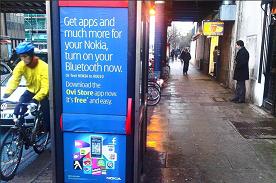
Mobile phones have become one of your portals to the digital world, so it’s only fitting that salesmen are starting to knock on that door. Major advertising companies are experimenting with interactive billboards that directly contact your mobile phone to offer promotional sales, information, or free apps. Some billboards are WiFi hotspots, some are Bluetooth enabled, and some simply react when you send them a text message. All are designed to transform those spare moments you spend in public into advertising opportunities. It looks like this might be one of the major emergent markets in the near future. According to the Wall Street Journal companies like Google, Nokia, and Orange have pursued wireless enabled interactive billboards on large campaigns in the US and EU. There are many examples of successful uses of this technology from recent years – you can see a few in the videos below. The billboard of the 21st century is still trying to get your attention, but it’s aiming at your phone, not just your eyes. Either way, it’s probably going to hit your wallet.
The premise of most posters and billboards is simple: they grab your attention, you look at them, you learn something that the advertising wants you to know. That’s not changed, but wireless communication is adding another layer. Instead of having to remember the information you see, wireless enabled interactive billboards send content to your phone. The transaction of data happens right there. It’s basically a point of sale, only for a coupon, free app, or advertising message. The following video shows a very simple scenario: a Bluetooth enabled poster sharing a promotional offer via a mesage:
BlueApricot, the makers of the poster in the video, have been doing this sort of advertising for years now. So have many others. Some, like BlueMedia have set up Bluetooth enabled zones in major metropolitan centers (like Times Square in NYC). Simply by walking through these areas with your Bluetooth feature enabled on your phone you could receive advertising messages about any sort of product they wish to promote. It’s billboard advertising without the billboard. Either way, your phone is a vital part of the interaction. The device has become a sort of sixth sense, and advertisers want to appeal to it.
That often means giving the viewer something on the poster they can control. Take for instance, the older interactive billboard in Berlin Dublin shown in the video below. By sending a text message to it, the viewer can activate a simulated car. Simple, but memorable:
For now, the dominant approaches to the phone are through text messages and Bluetooth. Amobee is one of the biggest names in mobile advertisement. They claim to be able to access 1 out of every 7 mobile phone users in the world. In September of 2010 they handled more than a million dollars worth of transactions in a single weekend (impressive considering how many mobile ads only offer free goods or data). Important to note is that less than 15% of phones used for these transactions were iPhone or Android platforms. The majority of the market is still clearly focused on phones without apps and (generally) without WiFi.
But that will change. Already major mobile companies are experimenting with ways to get users to download apps and other content. Nokia recently finished a major promotional campaign in the US, UK, Australia, and South Africa for their Ovi App Store. Posters advertising Ovi allowed consumers to download the free app for the Ovi App Store via Bluetooth or with a text message. According to the Wall Street Journal, the $1 million campaign attracted 1.5+ million interactions and was seen by tens of millions of people over 10 weeks. Perhaps a great return on the investment?
On March 1st of this year, Orange will start a 300 site campaign in London and NYC to promote its ON wireless app for Android. They will use WiFi enabled posters that allow customers to download the app while they wait for a bus. Google already did something similar in Boston with their Google Mobile app and WiFi routers at popular bus stops. Cemusa, the company that manages much of the bus stop advertising in NYC, has sold considerable advertising space to Amobee so that it can pursue marketing downloadable content through WiFi hotspots, text messaging, and Bluetooth enabled billboards. Things are heating up it seems.
It’s unclear to me what exactly the phone-targeted billboards of the future will actually be doing. Probably many different things. Some will be WiFi hotspots, providing a service in exchange for you receiving their ads. Others are going to spam you with messages (via Bluetooth?). Others are likely to really focus on the interaction, encouraging you to treat the ad as a game. Here’s a brief clip of a simple way that McDonald’s turned a billboard into a phone-enabled magnet to pull people into their restaurants. An easy game that gives you free food? Brilliant.
I only think this trend will increase in the years ahead. Think of all the visual advertisements you see in cities everyday. Most of us tune these images out, so that marketing companies become desperate to find new ways of grabbing our attention. We’ve already seen how new forms of digital signage will try to personalize their attacks on our senses. That’s one approach. The other is to skip our minds and head straight for our digital selves. Our phones are the frontier of advertising, and we carry them everywhere with us. Get ready for the onslaught of free, fun, and unavoidable mobile ads. It’s coming.
[image credits: Amobee via WSJ]
[sources: Amobee, Cemusa, Wall Street Journal]


